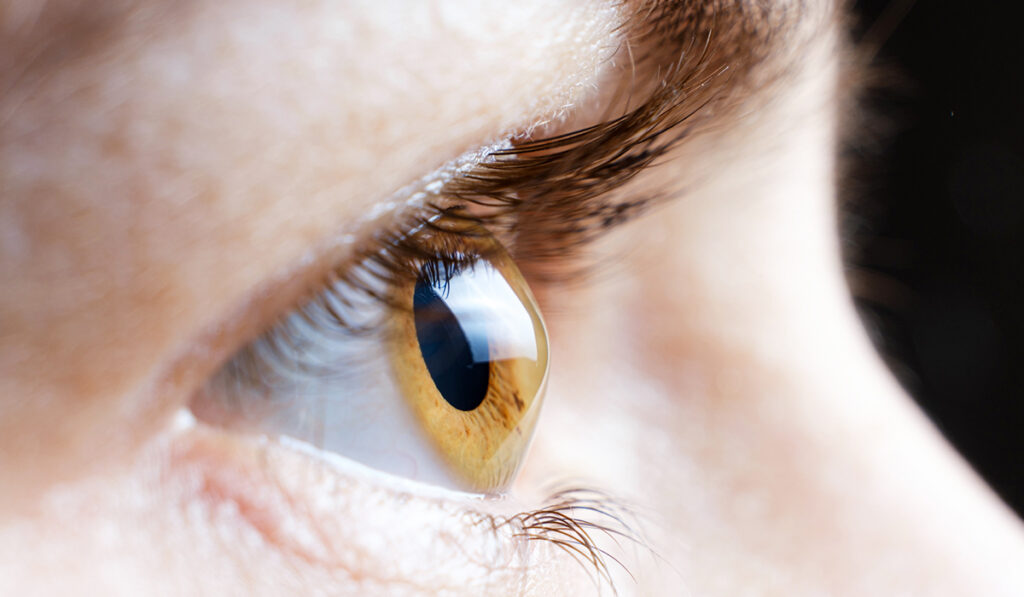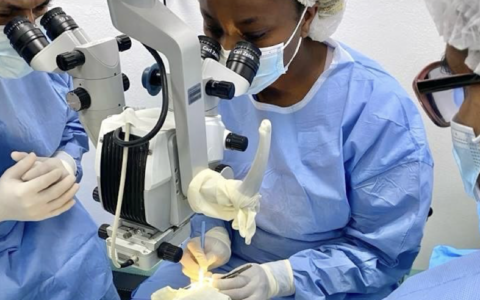Optometrists and ophthalmologists at Vanderbilt Eye Institute have been early adopters in the use of scleral lenses for treatment of complex eye conditions, including corneal irregularity, ocular surface disease and severe refractive error.
The variety of applications for scleral contact lenses has steadily increased over the last decade, but many are not yet fully aware of their potential benefits, said Dora Mathe, O.D., a Vanderbilt optometrist who specializes in complicated contact lens fittings and ocular surface disease.
At Vanderbilt Eye
“There are many indications for scleral contact lenses,” Mathe said. “They can improve dryness, they can help protect the corneal surface after surgery, and they can correct vision for patients who cannot wear traditional contact lenses.”
Designed to vault over the entire corneal surface and rest on the anterior sclera, scleral lenses can also be used to treat diseases like keratoconus and other forms of corneal ectasia with an irregular shape or buckling.
“With keratoconus, light scatters and the patient can’t see properly,” Mathe explained. “A scleral lens can improve the optics of the eye by creating a new front surface, almost like a prosthetic cornea.”
Patients don’t have to have a disease of the eye to wear scleral lenses, said Deepa Chandrasekaran, O.D.
“Scleral lenses can be used in patients of all ages. We even fit them for elderly patients; patients can wear them for most of their waking day.”
“Because of their size and comfort, they can be worn as a normal contact lens,” Chandrasekaran said.
However, high expense and lack of insurance coverage are among current obstacles to more widespread use.
“Scleral lenses can be used in patients of all ages, though we don’t usually recommend them for children,” Chandrasekaran said. “They’re a little bit difficult to put in, and they sometimes need to be taken out and cleaned during the day. We even fit them for elderly patients; patients can wear them for most of their waking day.”
Solution for Dry Eye
Dry eye can come from many sources, including hormonal changes, structural issues of the eyelid, trauma, tumor or environmental exposure. Impediments to the normal flow of tears have been traced to many sources, including antihistamines, beta-blockers and antidepressants, as well as diseases of the immune system, such as Sjögren’s syndrome, lupus, rheumatoid arthritis, thyroid eye disease, and type 1 diabetes.
Additionally, dry eye may occur when one or both eyelids are mispositioned, impeding a proper blinking motion. Scleral lenses address this issue by creating a space between the cornea and the lens that acts as a fluid reservoir, continuously bathing the cornea, Mathe said.
“Many patients cannot tolerate contact lenses because of dryness; scleral lenses are a great option for this.”
Treating Complex Eye Conditions
Scleral lenses can also play an integral role in the treatment of complex eye diseases. Among them is limbal stem cell deficiency that can arise from congenital conditions like aniridia or acquired conditions such as trauma, resulting in impaired vision or even blindness. It may also be caused by inflammatory conditions such as Stevens-Johnson syndrome, chemical or thermal injuries, and medication toxicity.
In recent years, limbal stem cell transplants have emerged as a successful treatment to restore vision. Mathe and Chandrasekaran work with Vanderbilt Eye Institute surgeons to fit scleral lenses post-surgery and protect the limbus from mechanical trauma while the eye is healing.
In graft-versus-host disease, with its risk of long-term immunosuppression and delayed healing, keratoconjunctivitis sicca is a common sequela, reported to affect 53 percent of patients.
“In graft-versus-host disease, where the patient has had a bone marrow transplant for cancer, sometimes the immune system will attack a patient’s corneas and they’ll have pain and light sensitivity,” Chandrasekaran said.
“The scleral lenses provide immediate relief. Not only do they get their vision restored and they’re able to get out of glasses, but they also have an immediate reduction in pain.”
Future of Scleral Lenses
“There’s research into using scleral lenses as a delivery mechanism for medication, as opposed to putting drops in 5 or 6 times per day,” Chandrasekaran said.
“It’s very rewarding to treat these patients. We have fitted some people with scleral lenses where their quality of life has improved dramatically.”
Chandrasekaran hopes to see the large patient financial burden shift as scleral lenses come to be more widely used.
“It’s very rewarding to treat these patients,” she says. “We have fitted some people with scleral lenses where their quality of life has improved dramatically.”






